Beautiful Plants For Your Interior
How to Build a Large Wildlife Pond
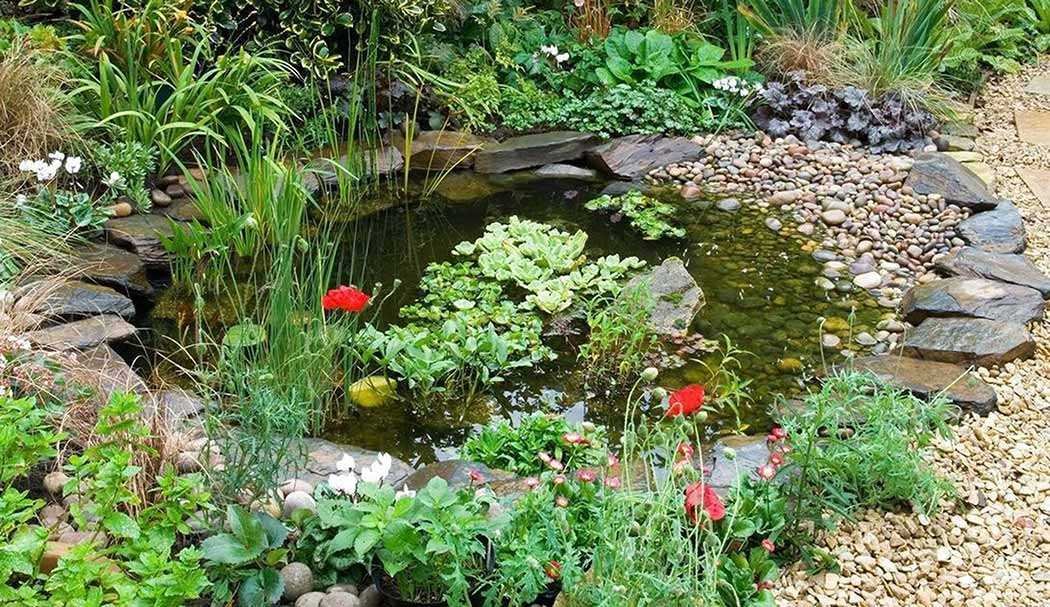
If you are wanting to know how to build a large wildlife pond in your garden, then you have come to the right place.
During the pandemic weeks and months of full lockdown in early 2020, many of us came to realise the sheer beauty of the natural world around us, which can be found in our own gardens. Various birds, bees, insects, mammals, frogs, dragonflies, and butterflies to name a few.
To entice even more visitors to our gardens a wildlife pond is a great addition to any garden. The wildlife pond just like bird tables and or hedgehog houses encourages some great British wildlife into our gardens throughout most of the year.
So with that being said and to hopefully keep your newfound enthusiasm going, we created this post ‘How to Build a Large Wildlife Pond in your Garden’ so let us get started.
Designing a Garden Pond
To build your wildlife pond make sure you have the following, based on the proposed size of your wildlife pond.
Materials
- Builders Sand (For Pond Lining)
- Aquatic Compost (For Planting)
- A Butyl Pond Liner
- Various Pond Plants
- Various Size Stone (Large to Small) Natural Stone
- Water Availability (For Filling Possibly Collected Rain Water)
- Thick Rope (For Marking Out)
Tools Required
- Spade or mechanical digger (Depending on How Large Your Wildlife Pond Will be)
- Spirit Level
- Plank of Wood (Straight)
Other Things to Consider
- The best time to construct your wildlife pond in your garden is over the autumn/winter period due to suitable ground conditions. The grounds tend to be not too wet or too dry, so it’s ideal for digging. Hopefully, your wildlife pond will be ready for spring and a host of new visitors.
- Always sketch out your pond on a piece of paper, with dimensions, depths, shape, and detailing slopes and banks even plants.
- Safety Requirements, especially if you have small children.
- Check for services (gas, water, sewage etc.) at your proposed pond location.
How Big Should a Wildlife Pond be?
As big as practicably possible is the answer, however, it is possible for all-size gardens to accommodate a water feature of some kind so do not think that you need a large garden for a wildlife pond.
Where Should a Wildlife Pond be Placed?
Planning is an important step when designing a garden pond. We can’t stress enough how important this is in the whole process of building your own wildlife pond in the garden, so please spend just a little time on this exercise, considering what has been discussed above.
Location or placement is one such planning step. Ideally, your pond should be placed in a level location. Do not worry though if you have ‘sloping’ high ground, just ensure your bank does not ‘fall or slide’ into the pond. Sloping banks can be made to look quite attractive with a running water feature into your wildlife pond perhaps.
Your location should also be a quiet, slightly shaded (not full sun) area away from the house, away from any overhanging bushes, and trees. Failure to place your pond in the right place could mean you spend the autumn removing leaves and debris from your pond.
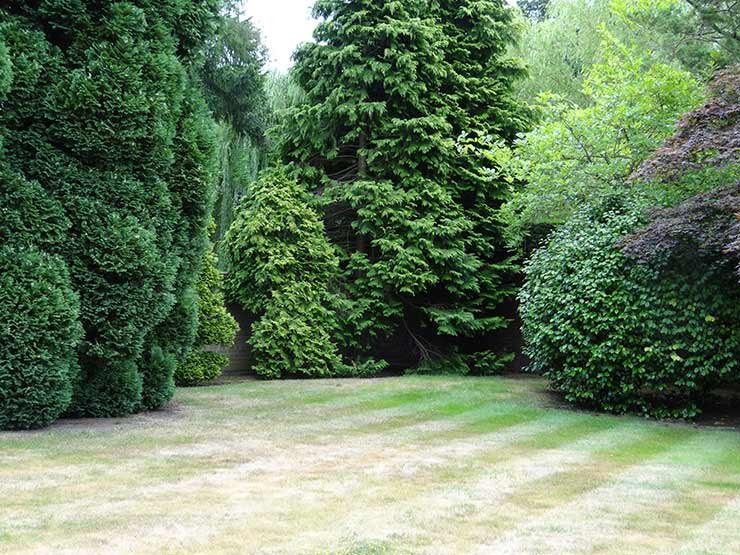
How to build a large wildlife pond: Choose your pond location carefully away from overhanging trees and bushes
Photograph courtesy of Claudia de Yong Designs
How Deep Should a Large Pond Be?
Step 1. Marking Out and Digging Out Your Pond
Considering what we have discussed so far, let us set out the pond outline, this is where our ‘rope’ comes in handy. Layout the rope in the chosen shape and dimensions of your pond, remembering to allow about 180mm outside the actual rope dimensions or edge of your wildlife pond. This is where you just need to eventually finish with your liner and cover it back over with ‘turfs’ you will dig out.
If you did not manage to get any rope, then some of your sand can be a good substitute to mark out the pond on the ground or even a garden hose.
Your wildlife pond needs to be between 60cm – 90cm deep at the deepest point and excavated to form varying depths. This can be done by forming ledges or shelves around the pond’s perimeter.
In addition to your ledges, at least 1-2 thirds of your pond should have gently sloping sides. This is to allow easier access and a way in or out for the wildlife. Also, when water levels fluctuate as often they do, it creates a ‘damp’ bog-type habitat which is vital for many beetles, bugs, and flies.
There are several reasons why shape and depth are important as we mentioned earlier. We form shelves for planting marginal plants in baskets and you also need a place that is deep enough for oxygenating plants and for wildlife to over-winter and or stay cool during the summer months.
Once your pond has been excavated place your plank of wood across the pond from side to side in several places to make sure that both sides of the pond are level. This will ensure that when you have filled your pond the whole of the liner will be covered, and parts not exposed to the sun.
Finally, before placing the ‘bedding’ sand you should ensure you remove all sharp objects like stones, twigs, protruding roots etc. from the bottom of your pond and your ‘formed’ shelves. This will avoid any possibility of costly damage to a pool liner when it’s placed, and your pond starts to fill with water.
Now place a 5 – 10cm thick layer of your sand to line the bottom of the hole, slopes and the ‘shelves’ you have cut, this should be ‘compacted’ down. Sand is preferable to ‘earth’ because it is sterile and moulds easily to the shape of the pond.
In addition, many people use old ‘carpets’ to pre-line their ponds, we still prefer soft sand, maybe the old ‘carpet’ can be used as an additional ‘pre-lining above the sand as a safety factor if required. The sand and the carpet are insurance against potential punctures.
Tip: If you are digging into a lawn save your turfs and put them to one side, as we can use them later.
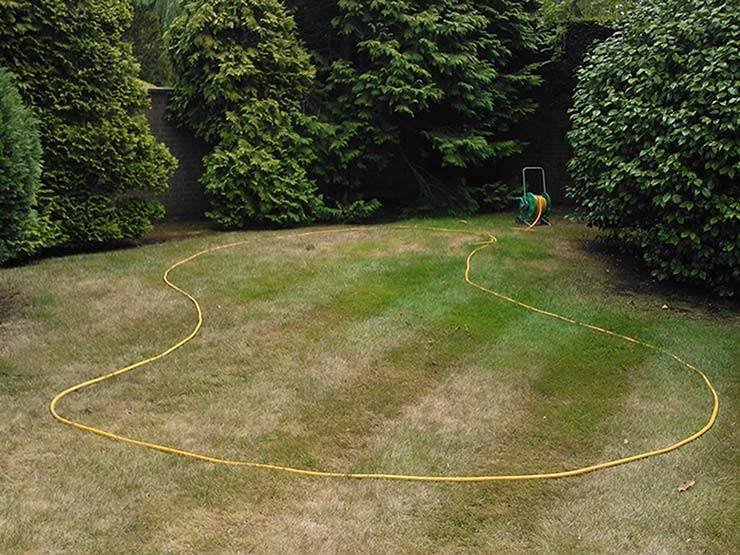
How to build a large wildlife pond: Mark out the shape of your pond with rope, sand or a garden hose
Step 2. Fitting the Pond Liner
Once your pond has been excavated and prepared as described in Step 1, it is time to place your liner.
What Type of Liner Should I Use?
There are other methods for installing a wildlife pond liner once your hole has been excavated, such as a preformed liner, or concrete-lined pond. These methods like concrete are expensive to create, with potential maintenance issues like ‘cracking’ for instance.
Preformed liners are difficult to install as you need to ensure that the hole ‘formed’ to take the liner is exactly the shape of your preformed liner and supported properly below to avoid liner damage at a later stage. So, both these options are best avoided.
For naturally shaped ponds, a ‘butyl’ rubber liner is recommended due to ease of installation, durability and of course, flexible liners conform to any shape hole. You will find a good pond liner that lasts maybe 20 – 25 years and should come with a warranty.
What Size Liner Do I Need?
So, how do you know how much pond liner you need? We’ve tried to make it simple by using our rule of thumb pond liner calculator below, which will provide you with a guide to the size of pond liner you will need.
To be able to calculate your liner size correctly there is a general rule of thumb that can be followed.
- Length of liner = maximum length of pond + twice maximum depth of pond + 1m
- Width of liner = maximum width of pond + twice maximum depth of pond + 1m
Example: A wildlife pond that has maximum dimensions of 6m x 4m and 1m deep would need a liner
6 + (2 x 1) +1 = (6+2+1) = 9m
4 + (2 x 1) +1 = (4+2+1) = 7m
The liner size required would be 9m x 7m
Just measure the length of your pond (L) your ponds (W) and your deepest depth (D)
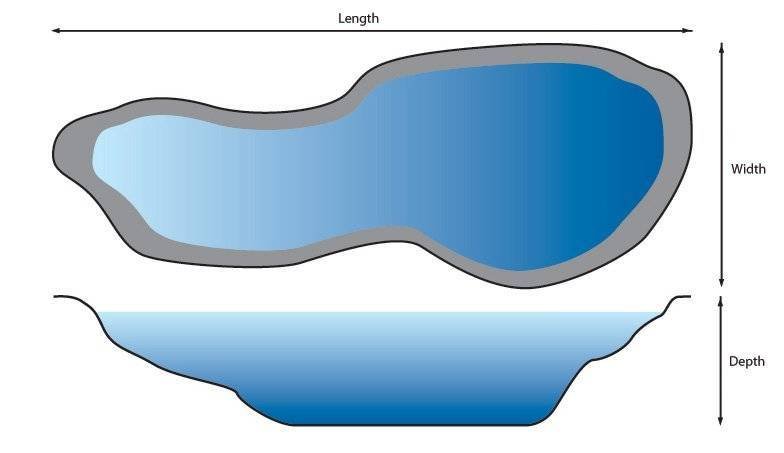
Then put your L x W x D dimensions into the pond liner calculator’s boxes where indicated and it will calculate the minimum pond liner size for you as a guide
You do not want to find out that the pond you spent hours digging, is too large for your liner. Therefore, always buy a liner that is slightly bigger than you think you will need.
You can use any excess liner to trim and place under other water features that you are building, or you can save it for a later date.
Fitting your butyl rubber pond liner is best undertaken on a warm day. This is simply because the pond liner will be more flexible, and you will be able to both fit and shape it a lot easier to form the shape of your pond.
Fitting a liner is a 2-person exercise. Unfold the liner on the grass or another clean flat surface nearby, then carefully begin to spread your pond liner evenly out over the excavated area.
Be careful to smooth out any creases and gently place the liner around all the contours, slopes and shelves formed in your pond, all the while making sure the liner extends beyond the perimeter of your pond.
Once this has been done and before filling with water, hold the liner down in place with some of the stone you have purchased, being careful not to hold it down too tightly as the liner will stretch and pull down to fit all the contours of the pond as you fill it with water.
You are now ready to fill your wildlife pond, but just before you do this, spread to around 50mm deep aquatic compost on the ‘bottom’ and ‘shelves’ of your wildlife pond. Also, try to avoid walking on the liner if you can.
The purpose of adding this type of compost is to ensure our aquatic plants can take hold and for the pond life to hide in. These ‘composted’ layers should be allowed to build up over time with falling leaves and such natural debris.
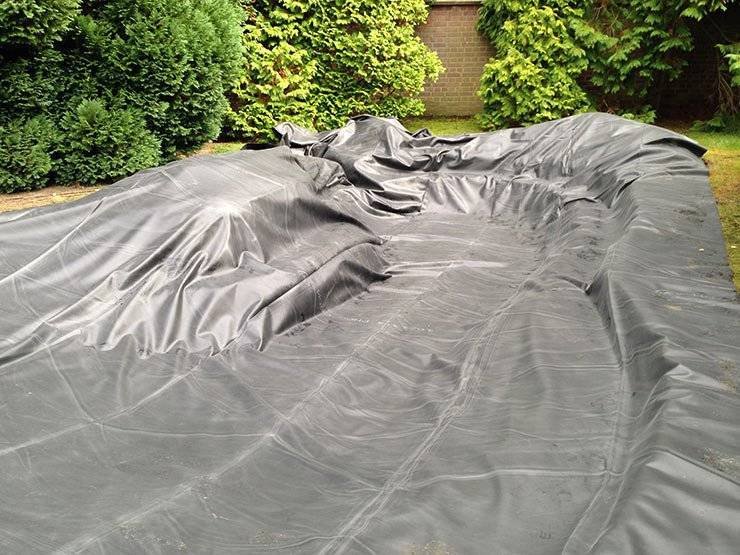
Once your pond has been excavated and prepared it is time to place your liner.
Step 3. Filling Your Wildlife Pond
Now you can start to fill your pond very slowly using a garden hose, take it easy and do not fill it too quickly as you will disturb the compost you just placed at the bottom of your pond.
Don’t forget as your pond fills, the liner will stretch so keep an eye on it, and slowly release the rocks, hold the liner and replace the rocks as the pond fills and the butyl liner stretches into place.
Once the pond is full, leave the water and liner to settle for a few days. Then trim the liner back leaving that 180 mm excess liner all the way around the perimeter you dugout. Now you can tidy and hide the liner to the exact pond edges using the grass turf you saved from digging the hole earlier.
Now you can place your natural stone as per your own design on top of the grass turf around all or part of the perimeter of the pond as designed.
Tip: Don’t forget to place a conduit or pipe before your’ turf’ and place the stones. This is for an ‘electrical’ cable to run through the ground, and running to the edge of the pond, above your liner. Do this for your pond pump and or if you are considering a small pond fountain or waterfall pump at any stage.
Your wildlife pond is now full of water and the liner is well ‘pegged down’ with turf and stone. Leave the pond for at least two weeks before planting as it will allow any chemicals from the tap water to evaporate away.
There you have it ‘How to Build a Large Wildlife Pond’. Now for the ‘planting’ of your wildlife pond.
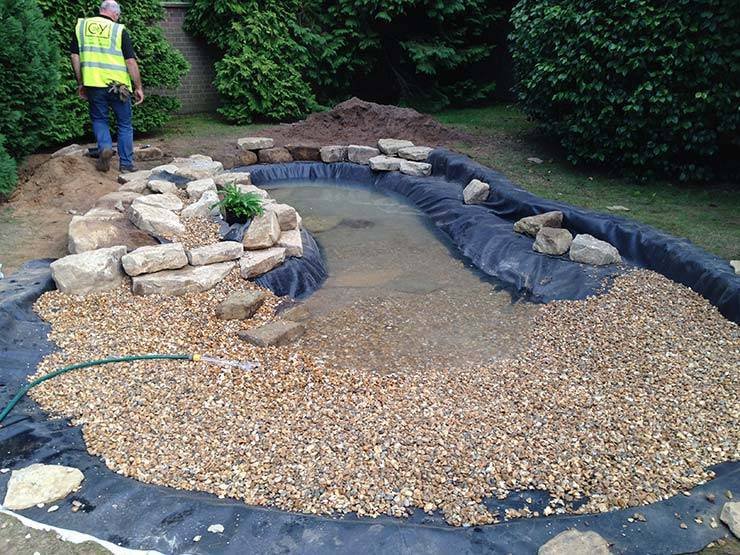
Once the liner is fitted and your pond floor is covered, gently fill your wildlife pond using a garden hose
The Best Plants for Wildlife Ponds
To achieve a correct water balance and to give your wildlife pond a good start, provide a variety of habitats in and around your pond.
To do this you need a mix of submerged oxygenators, floating aquatics, deeper water aquatics and marginal plants. You should consider these as four ‘zones’ in which pond plants may be grown.
Carefully select plants that will benefit the wildlife you hope to attract and select a good mixture.
Planting is where the deeper parts of our pond, cut shallower shelves and margins you prepared earlier come into play.
Zone 1. Oxygenating Plants
Use submerged plants to oxygenate the water making it more habitable for insects and amphibians.
Below are some of the best oxygenating plants for a wildlife pond
Curled Pondweed (Potamogeton crispus)
Rigid Hornwort (Ceratophyllum demersum)
Water Starwort (Callitriche stagnalis)
Spiked Water Milfoil (Myriophyllum spicatum)
Water Crowfoot (Ranunculus aquatil)
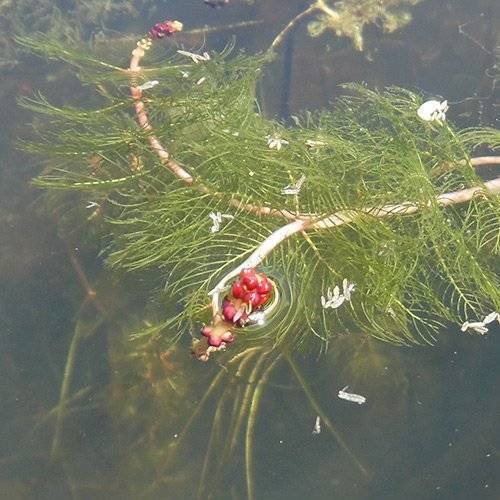
Spiked Water Milfoil (Myriophylum spicatum)
Zone 2. Marginals
Marginals need to grow at the shallow edges of your pond, place them so they extend out into the water. Interestingly some need to be permanently in a few centimetres of water, whilst other species can tolerate drying out on occasion.
Below are some of the best marginal plants for a wildlife pond:
Amphibious Bistort (Persicaria amphibian)
Arrowhead (Sagittaria sagittifolia)
Bog Arum (Calla palustris)
Brooklime (Veronica beccabunga)
Marsh Marigold (Caltha palustris)
Creeping Jenny (Lysimachia nummularia)
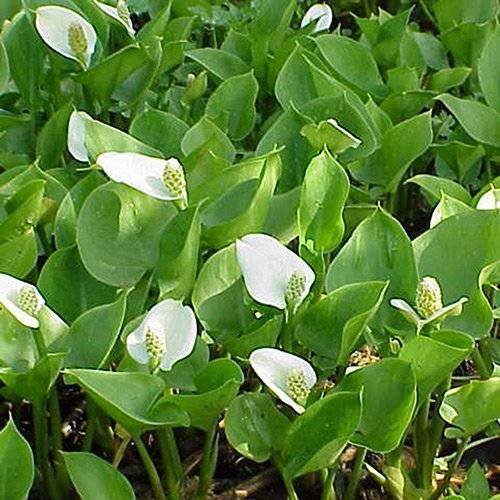
Bog Arum (Calla palustris)
Zone 3. Floating Plants
Floating Plants leaves float on the surface of your wildlife pond, they provide shade to the water below and help in reducing the growth of algae. Some varieties of plants may be rooted but others can and do float freely.
Another great bonus with the ‘leaves’ of floating plants is they act as ‘platforms’ for the viewing of courting or a variety of mating insects.
Below are some of the best-floating plants for a wildlife pond:
Frogbit (Hydrocharis morsus-ranae)
Yellow Water Lilly (Nuphar lutea)
Amphibious Bistort (Polyginum amphibium)
Broad-leaved pondweed (Potamogeton natans)
Water Soldier (Stratiotes aloides)

Frogbit (Hydrocharis morsus-ranae)
Zone 4. Emergent Plants
Emergent plants are usually rooted in the shallow regions (pond shelves) of a wildlife pond and emerge through the water.
Emergent plants provide an important and functional wildlife habitat. Many larvae of flying insects crawl up onto the stems to transform into their new form.
Emergent plants provide that transitional zone between the water’s surface and dry land and are very important for all sorts of wildlife.
Below are some of the best emergent plants for a wildlife pond:
Small Sweetgrass (Glyceria fluitans)
Branched Bur-reed (Sparganium erectum)
Yellow Flag Iris (Iris pseudocorus)
Greater Spearwort (Ranunculus lingua)
Greater Pond Sedge (Carex riparian)
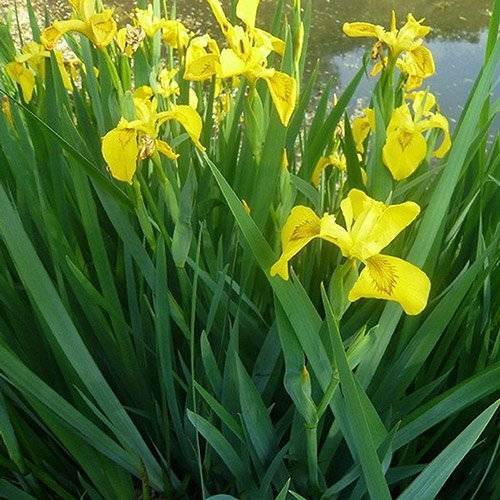
Yellow Flag Iris (Iris pseudocorus)
Where to Source Your Wildlife Pond Plants
We have given you some ideas on what plants are required and where plants are required to be placed in your wildlife pond.
There should be several places locally where you can source your pond plants and get advice. These include specialist water garden nurseries and the garden centres in your area or perhaps look at buying Amazon Pond Plants online and get them delivered directly to your door.

Success, your large wildlife garden pond is complete
FAQ’s
What Kind of Wildlife Can a Large Pond Attract?
A large wildlife pond can attract a variety of wildlife including amphibians like frogs, toads, and newts, insects like dragonflies and damselflies, as well as birds like swallows and house martins that come to drink and bathe.
How Can I Maintain a Large Wildlife Pond?
Maintaining a large wildlife pond involves regular tasks such as removing fallen leaves and debris, cutting back overgrown plants, and skimming the surface of the pond to remove algae. Check water quality regularly, and add new plants to the pond to keep it healthy and balanced.
Can I Add Fish to a Large Wildlife Pond?
Adding fish to a large wildlife pond can be detrimental to the pond’s ecosystem as they can eat tadpoles, frogspawn, and other small wildlife. However, if you still want to add fish, it is recommended to choose species that are native to your area and to ensure that the pond has enough vegetation and hiding places for other wildlife to escape.
Do I Need a Filter For a Large Wildlife Pond?
A filter is not always necessary for a large wildlife pond, especially if the pond is well-planted and has good water circulation. If the pond is heavily stocked with fish or if there is a lot of debris entering the pond, a filter may be necessary to keep the water clean.
Conclusion
Fantastic, your task should be complete if you have followed our ‘How to Build a Large Wildlife Pond ’ guide. We hope we have inspired you to get out over a few weekends and create your wildlife pond in your own garden, whatever its size.
Designing a garden pond, but not just any pond, one that has been specially designed by you and planted by you to provide habitats, cover, food and perches for a wide range of creatures that you will attract, will no doubt be very self-satisfying.
Attracting such a wide range of wildlife to your garden will provide you and your family endless hours of enjoyment and interest and you will be providing a home for a whole host of British wildlife to boot.
